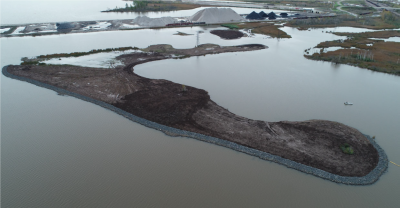The Minnesota Department of Natural Resources led a project at Kingsbury Bay and Grassy Point in the St. Louis River Area of Concern (AOC) to restore valuable coastal marsh habitat by removing excess sediment, remediating wood waste, and removing nonnative vegetation. The three‐year, $18M construction project was completed with funding from: the Great Lakes Restoration Initiative through USEPA; the Minnesota Outdoor Heritage Fund; and a St. Louis River/Interlake/Duluth Tar Superfund Site Natural Resources Damage Assessment and Restoration settlement. The mitigation of historic impacts to fish and wildlife habitat will continue efforts towards ultimately delisting the bistate St. Louis River AOC.
In Kingsbury Bay, approximately 170,000 cubic yards of excess sediment were removed, restoring an 80-acre shallow sheltered bay. A mile and a half downstream, legacy wood waste deposited into Grassy Point from historic logging operations were impairing aquatic habitat. At Grassy Point, approximately 130,000 cubic yards were excavated to restore a 230-acre coastal wetland and shallow sheltered bay complex. Some of the wood waste was also used to construct an 18-acre island, which will protect the bay and provide additional bird habitat. Clean sediment from Kingsbury Bay was used at Grassy Point as a cap at the island to facilitate healthy plant and wildlife communities. Together, this was a large and complex project to restore coastal wetland habitat, create open water, and improve recreational opportunities.



